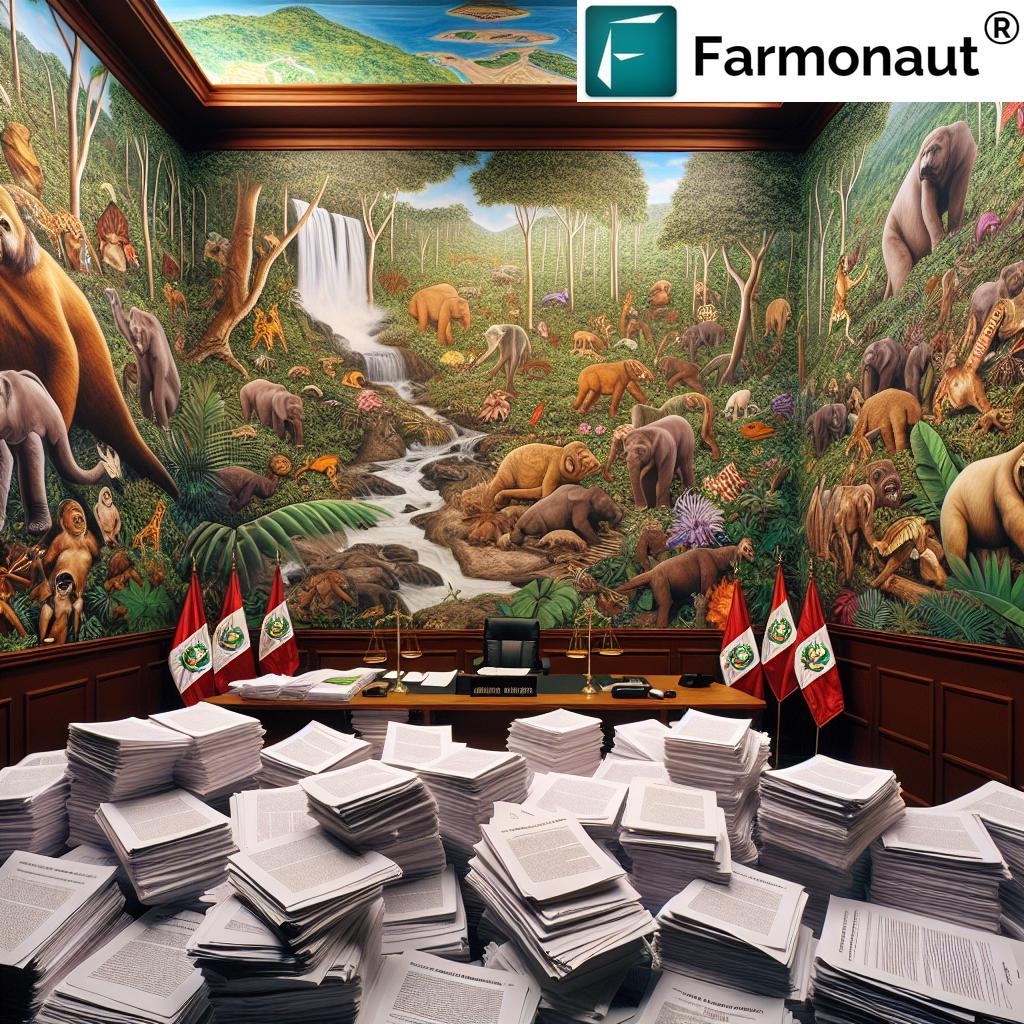Peru Environmental Law Amendment: 5 Urgent Risks to the Amazon
“Peru’s Amazon lost over 2.2 million hectares of forest between 2001 and 2020, threatening vital biodiversity.”
Table of Contents
- Introduction: Context and Urgency
- Summary of Peru’s Environmental Law Amendment
- Comparative Impact Table: Before and After the Amendment
- Risk 1: Accelerated Deforestation in the Amazon Rainforest
- Risk 2: Indigenous Land Rights and Territorial Risks
- Risk 3: Weakening of Environmental Regulations and Protections
- Risk 4: Legalization of Past Illegal Land Use Changes
- Risk 5: Increased Greenhouse Gas Emissions and Climate Impact
- International Implications: EU Regulations, Trade, and Precedents
- Sustainable Solutions: The Role of Technology in Environmental Monitoring
- FAQ: Peru Environmental Law Amendment & Amazon Risks
- Conclusion: Moving Forward with Responsibility
Introduction: Context and Urgency
Peru’s environmental law amendment is making global headlines due to the critical threats it poses to the Amazon, a region that not only defines Peru’s geographic and ecological identity but also anchors planetary climate stability. With the second-largest portion of the Amazon rainforest after Brazil, Peru sits at the epicenter of a pivotal environmental, legal, and social debate.
As environmental groups, indigenous communities, legal experts, and the international community raise alarms, it’s essential for us to unpack these reforms in detail. The Amazon is more than a national patrimony; it’s a linchpin for global biodiversity, climate regulation, and the protection of indigenous rights.
In this comprehensive analysis, we’ll break down the key changes introduced by the recent law amendment, highlight the five most urgent risks now threatening Peru’s Amazon, and explore what these changes mean for environmental sustainability, indigenous communities, legal norms, and the future of responsible development.
Summary of Peru’s Environmental Law Amendment
The Peru environmental law amendment—specifically, the change to the Forestry and Wildlife Law—has triggered intense debate throughout Peru, the Andean region, and globally. Enacted in March by an alliance of agribusiness, legal, and political interests, the amendment eliminates the previously mandatory requirement for landowners and companies to obtain state authorization before converting forested land to other uses.
Critics argue that this reform opens the door to legalizing years of illegal land use changes in Peru—particularly dangerous in a country where agribusiness and illicit activities such as illegal mining and drug trafficking often push into forested landscapes, including the Peruvian Amazon.
This amendment doesn’t merely loosen environmental regulations; it has the effect of privatizing national patrimony, despite constitutional safeguards.
Indigenous groups and environmental watchdogs warn of a dangerous precedent that could reverberate across other Amazonian countries, especially as global demand for deforestation-free products rises and economic pressures mount.
In the next sections, we’ll delve into a side-by-side comparison of the environmental, social, and legal landscape both before and after this amendment. This will highlight the scale of change and the direct risks Peru now faces.
Comparative Impact Table: Before and After the Amendment
To clearly understand the scope and urgency of risks, here is a comparative summary of the five key impact areas resulting from the Peru environmental law amendment:
| Risk Factor | Situation Before Amendment | Estimated Impact After Amendment | Potential Long-term Consequence |
|---|---|---|---|
| Deforestation Rate (% increase) | Deforestation regulated; increases kept under 1% annually with state approval process | 2–4% annual increase projected, due to bypassing authorization — especially in remote Amazon regions | Accelerated loss of Amazon forest cover; possible ecosystem collapse in vulnerable regions |
| Indigenous Land Affected (hectares) | Limited encroachment due to mandatory consultation and approval | Over 500,000 ha at near-term risk, as legal barriers and required consultation are weakened | Violation of Indigenous rights; forced displacement and loss of traditional territories |
| Number of Weakened Environmental Protections | Robust multi-level review (state, environmental assessment, indigenous input) | Protection mechanisms removed or sidelined (e.g., no mandatory impact studies or authorizations) | Legal framework undermined, setting precedent for future deregulation |
| Estimated Biodiversity Loss (species at risk) | Containment efforts through protection and monitoring; risk moderate | Hundreds of plant and animal species at high risk, particularly in adaptive areas near human encroachment | Permanent local extinctions; cross-border impacts on regional biodiversity |
| Carbon Emission Increase (tons/year) | Approximately 40–60M tons/year (eventually countered by reforestation policies) | Expected to surge by at least 10–20M tons/year due to expanded legal deforestation | Accelerated contribution to global climate change and Peru’s emission commitments |
Risk 1: Accelerated Deforestation in the Amazon Rainforest
At the heart of the amendment’s controversy is a regulatory rollback that allows land owners and companies to legally convert forested Amazon land to agriculture or other uses without prior state approval or environmental impact assessments. This opens the floodgates for:
- Legitimizing previously illegal deforestation in the Amazon rainforest
- Emboldering agribusiness, land-grabbers, and illegal mining expansion
- Enabling both legal and illegal interests to pursue profit at the rainforest’s expense
Peru’s territory encompasses more than 70 million hectares of Amazon—roughly 60% of the nation. The environmental consequences of accelerating deforestation will be global: loss of biodiversity, destabilization of local and continental weather, and massive increases in carbon emissions.
Critics, including environmental groups Peru and international experts, agree that this is a grave threat not only to the Amazon but also to Peru’s compliance with climate and trade agreements.
Learn about Farmonaut’s Carbon Footprinting Technology, which allows agribusinesses and organizations to monitor real-time emissions, supporting compliance with environmental regulations and sustainability goals. Monitoring emissions is increasingly important in light of legal reforms that threaten to elevate emission levels.
Key Takeaway: The amendment removes a fundamental environmental safeguard, setting the stage for a spike in agricultural expansion Amazon and rainforest degradation.
“Over 300,000 Indigenous people in Peru face increased land rights risks due to recent environmental law amendments.”
Risk 2: Indigenous Land Rights and Territorial Risks
Focus Keyword: Indigenous Land Rights Peru
The amendment sidesteps the rights of indigenous communities—something that Peru’s own constitution and Court have recognized as a violation. By removing the obligation to consult with Indigenous groups before altering the status of national forests, the legal changes directly endanger:
- Customary territories: More than 50 Indigenous Peoples, including many in voluntary isolation, face the prospect of their lands being reassigned or converted.
- Cultural and spiritual identity: For many Indigenous communities in the Peruvian Amazon, the forest is not just land—it is the essence of their survival, cosmology, and livelihood.
- Legal precedent: If Peru can override consultation and land protection in the Amazon, other South American Amazon basin countries might follow.
As Indigenous leaders fear, these reforms could set off a new wave of land grabbing, conflict, and forced displacement. Legal experts and environmental groups Peru agree: The amendment is a direct threat to the legal certainty and survival of Indigenous communities.
Discover Blockchain-Based Product Traceability Solutions from Farmonaut, ensuring transparency and accountability for agricultural products, and helping organizations document ethical sourcing—including the protection of Indigenous territories.
Risk 3: Weakening of Environmental Regulations and Protections
Focus Keyword: Environmental Regulations Peru
The Peru environmental law amendment rolls back decade-old protections that required rigorous oversight for forested land conversion. Key weakened safeguards include:
- No requirements for environmental impact studies prior to land conversion
- No mandatory state authorization for private or company-led land use changes
- Retroactive legalization of previously illegal land use change Peru
The Peruvian Court has recognized the Ministry of Environment’s role in zoning but did not reverse the pivotal provision that undermines the rule-of-law approach to conservation.
Why does this matter? Environmental regulations Peru existed to prevent exactly this kind of “legal backdoor” to deforestation and weakening of the national patrimony. Without these guards, sectoral interests are free to exploit the Amazon rainforest with little oversight.
Explore Farmonaut’s Farm Management Platform, which empowers both smallholder and large-scale farmers to practice precise, sustainable farming—key to minimizing unregulated expansion into environmentally sensitive territories.
Risk 4: Legalization of Past Illegal Land Use Changes
Focus Keyword: Illegal Land Use Change Peru
Perhaps the most damaging element of the amendment is its retroactive effect: land and agricultural products previously sourced through illegal deforestation or unauthorized conversion are now legalized. This means:
- Years of unlawful rainforest clearance are now seen as legitimate, weakening the deterrent effect of law
- Agribusiness and illegal actors that previously violated state or community regulations now have increased negotiating and financial power
- International trade commitments—such as deforestation-free products for the EU—are compromised
Legal experts term this a “dangerous precedent,” as it signals to other rainforest countries that enforcement can be reversed by political or economic pressure.
Access the Farmonaut Satellite and Weather Data API to independently monitor and validate land use changes, supporting NGOs, journalists, researchers, and responsible businesses in tracking compliance and prevention of illegal changes.
See Farmonaut Developer Docs for easy integration into your own monitoring systems.
Risk 5: Increased Greenhouse Gas Emissions and Climate Impact
Focus Keyword: Deforestation in the Amazon Rainforest
Forests are a critical carbon sink. The expansion of agricultural land and privatizing previously public forested property—as allowed by the new legislative framework—generates:
- Direct greenhouse gas emission spikes, undoing years of progress
- Possible international sanctions or reputational damage to Peru’s agricultural sector in global trade
- Weakening of forest stewardship, as local incentives and state protections are replaced by private interest
As regulations shift, the risk grows not just for Peru but for the future of global climate commitments. The national and international efforts on carbon neutrality and deforestation-free products must be doubled to compensate.
International Implications: EU Regulations, Trade, and Precedents
Focus Keyword: Environmental Regulations Peru, Trade Regulation, and EU Compliance
The amendment’s proponents claim that changes will help Peru comply with EU regulations on “deforestation-free” imports (coffee, cocoa, timber, etc.). However, EU officials have publicly denied any requirement for such deregulation. Instead:
- The EU and other trading partners want greater traceability and sustainability, not weaker oversight.
- When historic illegal deforestation is legitimized, Peru jeopardizes its standing in international markets and weakens global efforts including the Paris Agreement.
- The move could inspire similar reforms—and similar risks—in other Amazon basin countries, including Brazil and Colombia.
International attention is not just criticism—it’s a call for increased accountability and innovative solutions.
Explore Farmonaut’s Blockchain-based Traceability Solutions. These empower agricultural exporters and traders to track products from farm to shelf, providing proof of compliance for deforestation-free trade and supporting Peru’s economic interests while building global consumer trust.
Sustainable Solutions: The Role of Technology in Environmental Monitoring
With the weakening of formal environmental regulations, technology holds new importance for responsible entities—agri-sector businesses, NGOs, Indigenous groups, and policymakers. Satellite-based monitoring, AI-powered advisories, and blockchain traceability form a new toolkit for:
- Independent oversight: Real-time satellite imagery, such as through Farmonaut’s platform, enables remote detection of deforestation hotspots and illegal land use change.
- Protecting indigenous communities: Platforms offering geospatial and weather intelligence allow at-risk groups to document encroachment and advocate with evidence-backed reports.
- Supporting sustainable agriculture: Tools like Farmonaut Jeevn AI provide optimized crop and resource management, reducing the footprint of agricultural expansion and supporting eco-friendly yield increases.
- Enhancing fleet and resource utilization: Fleet management solutions help agribusinesses optimize logistics, reducing unnecessary land conversion and resource waste.
As Peru and other Amazon nations navigate the intersection of economic development and environmental protection, the scalable use of technology is more vital than ever. Precision monitoring helps responsible actors demonstrate compliance, adapt to new trade regulations, and fulfill their stewardship role.
FAQ: Peru Environmental Law Amendment & Amazon Risks
What is the Peru environmental law amendment and why is it controversial?
The amendment to Peru’s Forestry and Wildlife Law removes the requirement for state authorization before companies or individuals convert forested land to other uses. Critics argue it will legitimize illegal deforestation, threaten Indigenous land rights, and drastically weaken environmental regulations in one of the world’s most biodiverse regions.
How does this law amendment affect Indigenous peoples and their lands?
It weakens the consultation process that formerly protected Indigenous territories against encroachment by companies or economic projects. This places over 300,000 Indigenous people and their ancestral lands at risk of legal reclassification, deforestation, and potential displacement.
Why are environmental groups Peru and global organizations worried?
Environmental groups and legal experts warn that Peru’s precedent may be copied elsewhere, risking rapid acceleration in Amazon deforestation, biodiversity loss, and failures in fulfilling climate and trade commitments.
Are there technological solutions to help address these risks?
Yes! Advanced platforms like Farmonaut use satellite imagery, AI, and blockchain to empower remote monitoring, traceability, resource optimization, and real-time reporting for environmental compliance, supporting both sustainability and responsible economic development.
What can Peruvian agribusinesses and farmers do to stay compliant with EU and global standards?
Agribusinesses should adopt product traceability, carbon tracking, and precision monitoring solutions to ensure their products are not linked to recently deforested or illegally converted land, thus remaining aligned with both national and international sustainable trade norms.
Conclusion: Moving Forward with Responsibility
The Peru environmental law amendment marks a critical flashpoint in the battle for the Amazon, Indigenous land rights, and responsible development. The risks—from skyrocketing deforestation to weakened legal protections and undermined global trade credibility—demand urgent scrutiny, transparent action, and robust technological support.
As we strive for economic growth, let us remember that the Amazon is not mere property; it is a pillar of global climate health and cultural heritage. Navigating these complex stakes calls for cross-sectoral commitment, innovative solutions like Farmonaut’s real-time farm monitoring, and unwavering advocacy for both people and planet. Our choices today will define Peru’s environmental legacy—and that of the Amazon—for generations.
Let’s prioritize sustainability, transparency, and responsible stewardship of Peru’s rainforest patrimony—leveraging every tool at our disposal.
















